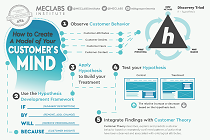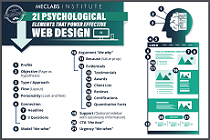
|
SUMMARY:
People are logging in to Twitter and Facebook to interact with not only friends and family, but with companies and brands, too. But while comments and tweets rack up to form valuable discussions on social media, what's your next move from a marketing standpoint? How do you carry on these conversations past the realm of social media? |
by Allison Banko, Reporter
Action Box: Get Productive With AI
Want to apply data-driven insights? Join us for ‘Get Productive With AI’ on Feb 27th – free from MeclabsAI (MarketingSherpa’s parent organization).
IBM is one of the world's largest technology companies — and it's one of the longest standing firms with roots in the 19th century. As "Big Blue" treks on in tech, it continues to calibrate its marketing compass.
Most recently, the team has opted to look at its marketing through four key categories:
"The idea behind looking at things that way is it's better reflective of the external market, rather than the internal marketing structure," explained Matt Carter, Program Director, Digital Marketing for Big Data & Analytics, IBM. "We're looking at marketing like our audience would look at it."
In Carter's area of specialty, Big Data & Analytics, the team had been emphasizing social network outreach, achieved through contributing to conversations about the topic in online communities, groups and forums.
"The object is to add something of objective value to the conversation," Carter explained. "Not just 'buy our stuff' messaging, but actually educate the market, make them better consumers, provide the sort of information that they need to be more adept at big data and analytics in their own lives."
Additionally, the team created engagement across its own social networks including its LinkedIn groups, Twitter profiles and Facebook pages.
However, from there, visitors were directed to static product webpages IBM had integrated from its acquisition companies.
"When you take someone from a social environment, they're used to real-time updates," Carter said. "They're used to conversational tone. They're used to input from various sources, and it's fast. If you're not watching it, you're going to miss something. There's a built-in sense of urgency to consumption present on social networks that it's really hard for a static webpage to emulate."
The team saw high abandonment on those static webpages and suspected that people were getting there through links on their social networks. Because visitors wouldn't see things similar to the social environment they were coming from, they’d leave.
"You're creating this cycle, but you're never really bringing someone into your own environment, your own ecosystem," Carter said.
He added that the IBM team needed to create a warm landing spot for people coming from those dynamic, real-time social media environments to increase exposure to IBM messaging and content via social engagement.
As opposed to the current tactic of collecting traffic from social and sending it to corresponding static pages on IBM.com, this area would ideally offer people the content they're actually looking for, provided in a format that’s easily sharable through social networks.
With that, the Big Data & Analytics Hub was born: a dynamic website optimized for multimedia content, search and social sharing.
The idea was that this site would complement the IBM.com Web properties and increase engagement with its content, serving as a spot where visitors could go to learn more about big data. While exploring the site and sharing the media content pieces that speak to them, visitors could then go to product conversion spots on the IBM.com webpages.
"We think that by creating a more educated and astute audience on Big Data & Analytics, IBM products become the logical choice," Carter explained. "So we created an environment that they can educate themselves objectively and not really be subjected to the hard sells. But in that environment and in that content, while they educate themselves, we provide opportunities for them to explore IBM content more deeply or IBM products, solutions and services."
The essence of IBM's marketing is to be better reflective of the external market, so rather than developing a digital property based on what IBM wanted to share, the team wanted the Big Data & Analytics Hub to reflect what the audience wanted to talk about.
To achieve this, the team conducted "a tremendous amount" of social conversation analysis around the Big Data & Analytics conversation.
Through the use of proprietary social analytic software, the team could examine the totality of the digital conversations, including those from:
"Staring at that research and getting in a room with our vendor and going over it exhaustively helped us define how the experience was created and executed on the Hub itself," Carter said.
From those findings, the team defined aspects of the Big Data & Analytics Hub such as its navigation. For example, the research showed that content analytics, customer analytics, entity analytics, predictive analytics and social media analytics surfaced as trending topics, so they were bucketed into the high-level navigation.
With the structure of the site nailed down, the team next needed to discover how to produce the content that would bring it to life.
"We had to create a pretty intricate internal machinery to ensure that we were either A, my team itself producing high-quality content at a very, very brief length schedule, or B, we were connected to the various subject-matter experts throughout IBM whom we could source content from," Carter said.
Thus, a Big Data & Analytics Hub editorial board was created. Comprised of about 30 members from various disciplines throughout IBM, the board would meet weekly to examine social data, determine what the audience wanted to learn about and, of course, assign corresponding content.
"The editorial board itself is all part of the IBM family," Carter explained. "These were people within IBM who were subject-matter experts on the important topics that we identified from the external research."
After discovering the trending topics the audience wanted to consume and pairing them up with IBM’s internal and external subject-matter experts, the team next had to determine how to deliver the Hub’s content.
"We find out how to connect [experts'] knowledge and expertise to what the audience wants to know about," Carter explained. "We start to get a sense of how to bridge the divide there, then we take a look at the content that would effectively bridge that divide and we determine the optimal form factor for delivering it."
The Hub's wide range of content types include:
Take one of IBM's internal subject-matter experts, James Kobielus. He's Senior Program Director at IBM and is dubbed as a Big Data Evangelist for the Hub.
Kobielus' focus has been on data scientists and their emerging role. The team noticed that Kobielus is very "prose-oriented."
This, along with the fact that the topic is in an educational stage with the audience, helped the team determine that the best form for him to present his expertise was through a blog series.
"Other topics, however, people are looking for the highlights, or they want something flashy and dynamic," Carter said. "It's really always back to the data. Find out what the audience wants to know about. Find out who knows about that topic. Then, between the two, find out the best form to serve folks."
A recent development in the Hub has been the introduction of episodic content. Rather than solely creating one-off content, the team has started to produce content that appears on a predictable schedule.
The team thinks of it like episodes from a TV series. For example, the live video chat show "Big Data Bytes" occurs the first Friday of every month.
"We're building repeat visitors at a rate previously un-thought of," he said. "People are coming and they're learning to anticipate when new content will be published in a form that they happen to prefer, and they're coming back to the site to find it."
The next piece was figuring out how to drive visitors to the Big Data & Analytics Hub. This involved taking a deep look into how IBM was currently utilizing its social networks. Whereas before social networks served as IBM's engagement destination, they'd now be a pit stop along the way.
"We used our social networks to kind of spark intrigue among our audience and then provide pathways back to satisfy that intrigue on the Big Data Hub," Carter explained. "We stopped looking at [our social networks] as a prominent place to create engagement and started looking at them as almost ponds to fish for our audience, and then bring them into our own environment."
The content was ensured to be not only consumable, but easily shared on social networks, too. Visitors can become advocates of the Hub through promoting the site on their own accounts.
"We make the path from content consumption to content advocacy a short one-click path," Carter explained.
Because the site was designed to be optimized for social search, the hub is also attracting plenty of visitors through search engines results.
Content is uploaded to the site multiple times a day, positioning the dynamic site in favor over static pages in search engine algorithms. The hub was also built in responsive design, making it consumable through multiple devices.
"If we would have had to spend a large amount of paid media dollars to drive visitors to the hub, the experiments or the concept I think would have been a failure," Carter said. "The whole point was that we were serving an existing audience's needs, and by optimizing everything, the audience would come to it. That started to work."
According to Carter, the time it took from the drawing board for the Hub to go live was about four months.
By the day the Hub launched, the team was already dozens and dozens pieces of content deep on all the topics set to be presented on the site.
When the team was developing the actual physical manifestation of the online Hub, individuals were simultaneously assembling existing content. This process involved identifying those sources of expertise within IBM and looking at existing content they had. Then, the team needed to figure out how to transform it into a different media type easily consumable and optimized for sharing. Because the site was built upon the foundation of up-to-the-minute content, ensuring a large queue was in place was imperative for launch.
"Every single facet of the user experience on the Hub needed to feel dynamic," Carter said. "It needed to feel real time, constantly updated, fluid and flexible."
While the Big Data & Analytics Hub is an ongoing project, from January 2013 to January 2014 the site experienced:
Carter attributed the Hub's success to its objectivity, serving as an environment that reflects its audience’s daily reality with relevant content.
"All too often, companies today are so focused on what they want to tell the audience and are less focused on what the audience actually wants to hear about," he said. "You've got to be able to fully understand your audience to a degree that you almost intimately understand what they want to know about, and then design an environment that provides that to them."
IBM
Matt Carter, Program Director, Big Data & Analytics Category Digital Marketing
David Pittman, Social Strategist
Stephanie Caputo, Market Segment Manager
Grove Marketing
Pete Izzo, Principal
Make data make sense: IBM Watson Foundation [Video]
Persona Marketing: NetProspex increases website visit duration 900%, lifts marketing-generated revenue 171%
B2B Content Marketing: Software company increases list 130% with content curation
Social Media Marketing: 4 questions to ask yourself about social media buttons
Get Better Business Results With a Skillfully Applied Customer-first Marketing Strategy

The customer-first approach of MarketingSherpa’s agency services can help you build the most effective strategy to serve customers and improve results, and then implement it across every customer touchpoint.
Get More Info >MECLABS AI

Get headlines, value prop, competitive analysis, and more.
Use the AI for FREE (for now) >Marketer Vs Machine

Marketer Vs Machine: We need to train the marketer to train the machine.
Watch Now >Live, Interactive Event

Join Flint McGlaughlin for Design Your Offer on May 22nd at 1 pm ET. You’ll learn proven strategies that drive real business results.
Get Your Scholarship >Free Marketing Course

Become a Marketer-Philosopher: Create and optimize high-converting webpages (with this free online marketing course)
See Course >Project and Ideas Pitch Template

A free template to help you win approval for your proposed projects and campaigns
Get the Template >Six Quick CTA checklists

These CTA checklists are specifically designed for your team — something practical to hold up against your CTAs to help the time-pressed marketer quickly consider the customer psychology of your “asks” and how you can improve them.
Get the Checklists >Infographic: How to Create a Model of Your Customer’s Mind

You need a repeatable methodology focused on building your organization’s customer wisdom throughout your campaigns and websites. This infographic can get you started.
Get the Infographic >Infographic: 21 Psychological Elements that Power Effective Web Design

To build an effective page from scratch, you need to begin with the psychology of your customer. This infographic can get you started.
Get the Infographic >Receive the latest case studies and data on email, lead gen, and social media along with MarketingSherpa updates and promotions.